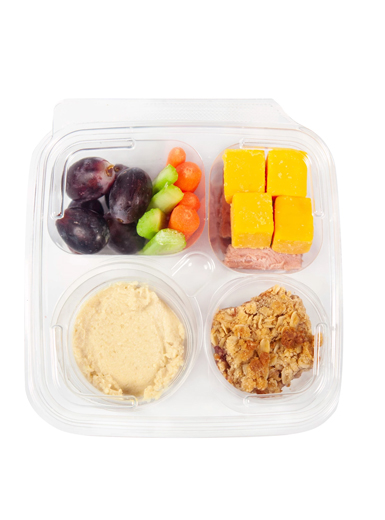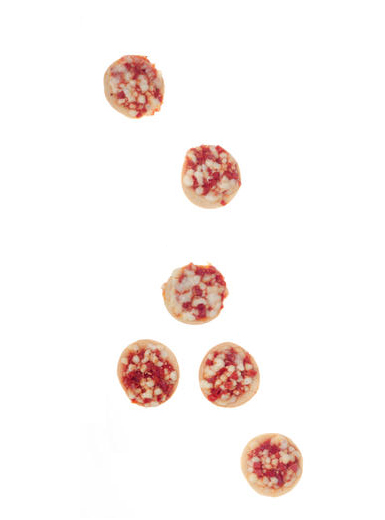Solutions to 7 Sticky Snacking Situations
Snacks can easily be something to grab-n-go! Whether you invest a little effort to prep snacks ahead of time or purchase one of the many available options at the grocery store, a quick snack “helps bridge the gap between meals,” as Kimberlain puts it.
It used to be that eating between meals was a “no-no.” Snack food was often equated with junk food. But no more! Eating healthy snacks in between meals can give you an energy boost, keep you satisfied and help prevent overeating at meals. The right snacks can add fiber and nutrients to your day without an abundance of calories.
Many people know this but still end up stretched thin and starving by the next meal or dragged down by fat and calories. Why? Several obstacles can stand in the way of snacking smart. We dug in with the help of Amy Kimberlain, RD, Spokesperson for the Academy of Nutrition and Dietetics in Miami, Florida, to find solutions for seven common snack problems.


Follow These 7 Solutions


01.
NO PREP TIME
Snacks can easily be something to grab-n-go! Whether you invest a little effort to prep snacks ahead of time or purchase one of the many available options at the grocery store, a quick snack “helps bridge the gap between meals,” as Kimberlain puts it. She suggests protein packs, nuts pre-portioned with dried fruit or simply a banana or apple. An individual tuna salad kit complete with crackers is another quick option. Even a package of peanut butter sandwich crackers or small 1.5 ounce energy bar works.
02.
DIETING
If you think you need to avoid snacking to curb overall intake, think again. Kimberlain comments that “going too long without eating may sometimes lead to overeating.” Crunchy fruit or vegetables provide bulk with fewer calories, such as fresh fruit bowl, celery sticks, baby carrots, sliced cucumbers, mini bell peppers, and sugar snap peas. Those are light enough to combine with a couple tablespoons yogurt dip or hummus. Items under 150 calories like these Avocado Turkey Roll Ups and Strawberry Coconut Energy Bites, as well as low-sodium V8® juice, also serve for calorie-controlled snacking.


03.
CARDIAC DIET
Sensible snack choices can be part of a heart-healthy diet! Low-saturated fat foods that have moderate protein or high fiber will satisfy between meals. Pick items with 2 or more grams of fiber per serving. Functional foods that include omega-3 fatty acids or calcium + vitamin D are also heart-smart. Our top recommendations include grapes & almonds, peach & nonfat cottage cheese, and a whole-wheat waffle with 1 Tbsp. peanut butter and a few berries. Create your own 3-ingredient trail mix with 1 cup pretzels or dry cereal, 1/4 cup raisins or other small dried fruit, and 1/4 cup cashews or pistachios; makes 4 servings.
04.
ATTACK OF THE MUNCHIES
Having a salty, crunchy snack craving can lead you to grab a not–so–healthy treat. Goodbye chips — Kimberlain states, “There are several savory foods you can purchase ahead of time and portion out at home to meet your salt cravings. This way you can grab a healthy snack to take to work, instead of grabbing something salty from the vending machine.” Find a microwave low-sodium popcorn in single-serve (usually 100 calorie) bags. Try seasoned roasted chickpeas, dry roasted seaweed sheets or freeze dried crunchy veggies. Aim for 200 mg or less total sodium per snack.


05.
MEALTIME MISHAP
When you’ve missed a meal or are running a couple hours behind, cramming in a full meal before yet another one later may do more harm than good. Mini-meals that are filling yet calorie-controlled resolve this situation. Here are some of our favorites… Half quesadilla: whole wheat tortilla with a slice of reduced fat cheese, leaves of spinach and a spoonful of salsa, folded and pan warmed. Mini pizza: grain bagel half topped with marinara sauce and shredded low fat cheese, broiled until cheese is melted. Potato bites: split 4 creamer potatoes, scored and microwaved open-faced with broccoli bits, then topped with nonfat cottage cheese and a squirt of hot sauce.
06.
DESSERT DOWNFALL
Instead of giving in to your sweet tooth’s urge for a dessert, consider healthy alternatives. Kimberlain says, “While it’s OK to indulge your cravings every now and then, there are healthier options out there that will help satisfy these cravings.” Try a slice of cinnamon toast or a few graham crackers instead of rich baked goods. Opt for flavored yogurt instead of ice cream or pudding. For a fruitier flavor, pop berries into your mouth for sweetness with each bite or mix diced apples with a couple spoonfuls light whipped cream and walnuts.


07.
NUT-FREE AND VEGETARIAN
There’s more to snacks than carb-loaded starches like pretzels for vegetarians who also need to avoid nuts. Protein helps you feel fuller longer, and meat-free protein sources are no exception. Kimberlain shares that “there are plenty of quick, nut-free snack options that pack lots of protein.” Her top suggestions are edamame, hard-boiled egg, hummus (or other bean dips), and cheese with fruit. A high protein skyr or Greek yogurt with granola is another good option, as is a sunflower seed butter + sliced banana–topped English muffin half.
Smart Snacking Tips
- Plan ahead. Kimberlain encourages, “Snacks don’t have to take a lot of time – and by having a few snacks ready-to-go you’ll set yourself up to have healthy options accessible.”
- Keep a supply of shelf-stable healthy snacks in your office or car to prevent last minute trips to the vending machine or drive-thru.
- Focus on plant foods and fresh produce. Stock the fridge with fresh fruits and vegetables, washed, pre-cut, and ready to grab.
- Remember, a snack is meant to tide you over between meals, so keep portions small – no larger than the size of your fist.
- Limit pre-packaged snacks containing more than one serving per package and divide bulk foods into individual portions ahead of time.
- In general, keep snacks under 250 Calories for men and under 200 Calories for women.
- For snack satisfaction that keeps hunger at bay, try combining a complex carbohydrate with protein.
- Foods that provide varying textures (crunchy, soft) and flavors (sweet, savory) are more appealing and hold your taste interest.
